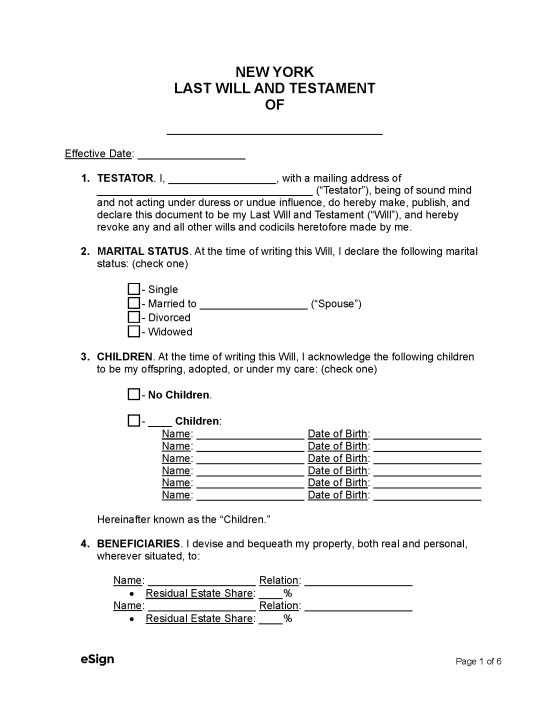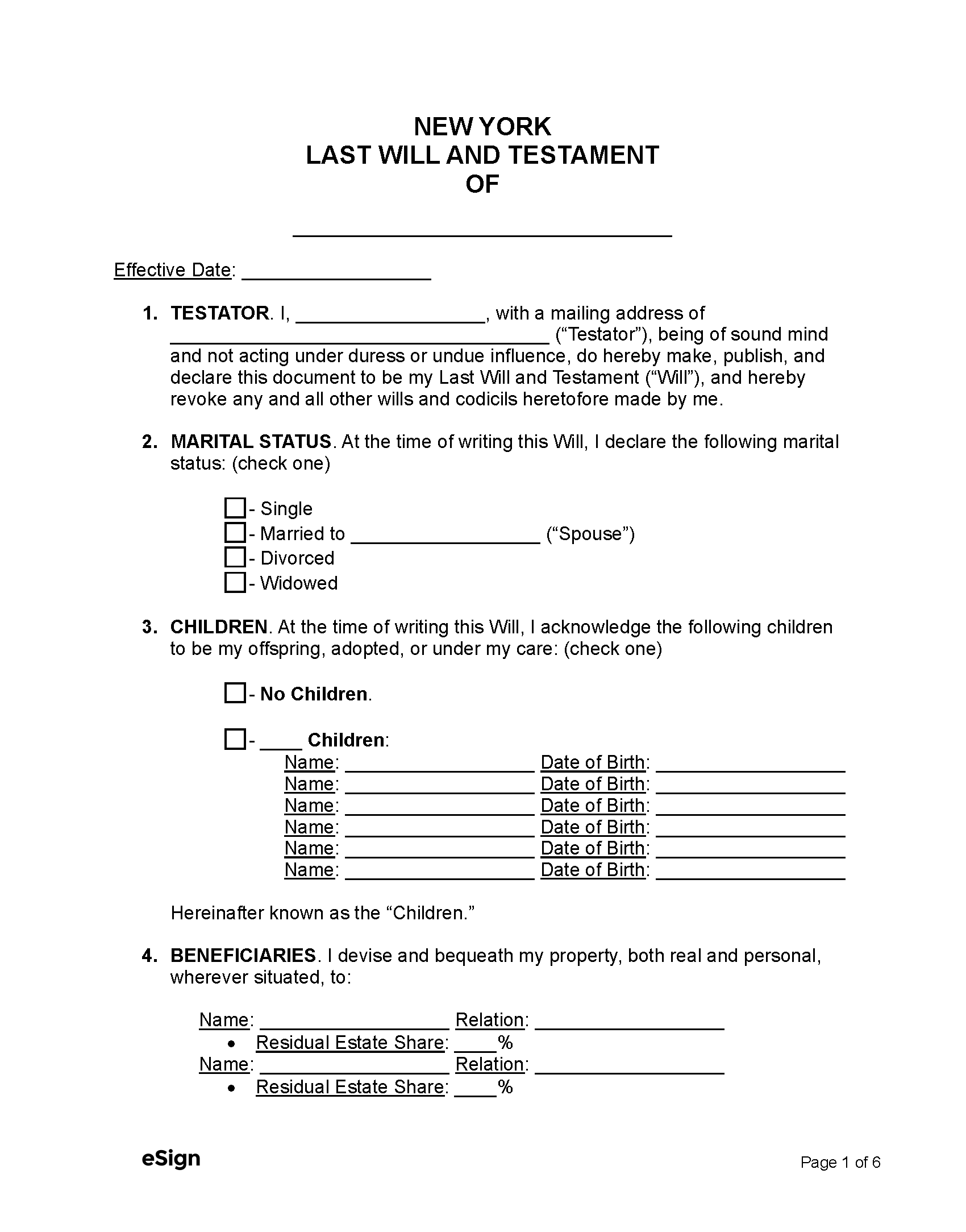A New York last will and testament is a legal document that explains how an individual wants their estate to be transferred when they die. The will names beneficiaries of the deceased person’s property and lists the inheritance each is entitled to receive. It also nominates someone to serve as the will’s executor (or “personal representative”). This person is responsible for handling legal paperwork, settling debts, and distributing assets as per the will’s instructions.
Any person at least 18 years old and of sound mind and memory can create a will.[1]
State Laws
Holographic Wills – Holographic wills are only valid if made by:[2]
- A member of the US armed forces while in a war or armed conflict.
- A person serving alongside or accompanying an armed force during a war or armed conflict.
- A mariner at sea.
Revocation – A will can be revoked by destroying the original, creating a new will, or writing a revocation document that follows the same signing and witnessing requirements that apply to wills.[3]
Signing Requirements – Must be signed in the presence of two witnesses, and both witnesses must sign and provide their addresses at the bottom of the document.[4]
Probate Process in New York (11 steps)
After a person dies, the court must review the individual’s will to see if it is valid and meets all the necessary legal requirements. This process is called probate and should begin as soon as possible after the person’s death, though there is no specific time limit set by law.
- Gather Initial Documents
- File Probate Case
- Send Notice of Probate
- Purchase Bond (If Applicable)
- Obtain Letters Testamentary
- Determine Value of Assets
- Apply for EIN & Pay Taxes
- Pay Debts
- Sell Assets (if required)
- Prepare Accounting Report
- Close Estate
1. Gather Initial Documents
Probate can be avoided if the decedent’s estate is valued at $50,000 or less and consists of personal property only. If this applies, a Voluntary Administration proceeding will need to be initiated with the surrogate’s court.[5]
The person listed as executor in the decedent’s will must prepare the following documents for submission to the court:
- Original Last Will and Testament
- Death Certificate
- Petition for Probate (and Letters Testamentary) – Must report the:
- Estimated value of the decedent’s personal property and real estate.
- Names of all beneficiaries and heirs.
- Estate liabilities (e.g., mortgages, credit card debt).
- Supporting Documents (included in Petition for Probate):
- Affidavit of Attesting Witness – Completed by each witness to the original will.
- Waiver of Process (Consent to Probate)* – Completed by the decedent’s heirs if they do not contest the will.
*If the decedent’s heirs contest the will and choose not to sign a Waiver of Process (Consent to Probate), they’ll receive a Citation by mail. This document will notify them of a scheduled court hearing where they can appear to voice their objections.
2. File Probate Case
After preparing the initial probate documents, the executor will need to file their paperwork and pay a filing fee. The documents and payment must be submitted to the surrogate’s court in the county where the decedent lived at the time of their death.
- Court Locations – Inside NYC | Outside NYC
- E-Filing – Courts on this list accept paperwork online via the NYSCEF system.
3. Send Notice of Probate
A Notice of Probate has to be mailed to each person with an interest in the estate, including the beneficiaries, creditors, and heirs at law (i.e., the individuals who would inherit assets if no will existed).[6] After the mailing is completed, the executor must file an Affidavit of Mailing Notice of Probate for each notice they sent.[7]
Unlike many other states, New York doesn’t have laws requiring executors to publish a notice in a local newspaper to inform creditors of the decedent’s passing.
Note: Both the Notice of Probate and Affidavit of Mailing Notice of Probate are included in the Petition for Probate.
4. Purchase Bond (If Applicable)
Unless the bond requirement is waived in the decedent’s will, the court may demand the purchase of a bond to protect the estate against potential fraud, negligence, or other issues caused by the executor.[8] Bonds can be obtained from surety companies, such as:
5. Obtain Letters Testamentary
After the surrogate’s court has confirmed the will’s legitimacy, ensured that all relevant parties have been notified, and verified that the executor is qualified to administer the will, they’ll issue an Order and give Letters Testamentary to the executor. This document gives the executor permission to handle the estate.[9]
6. Determine Value of Assets
After receiving the Letters Testamentary, the executor will need to determine the value of all assets belonging to the decedent. Paperwork relating to the following can assist in determining the value of assets:
- Tax returns
- Vehicle registration and insurance forms
- Credit card bills
- Real estate documents (e.g., deed, mortgage) and tax bills
- Business filings
- Life insurance policies
- Medical and Medicare information
- Investment statements
An Inventory of Assets reporting the value of the decedent’s estate must be filed with the surrogate’s court within nine months of the date the Letters Testamentary were issued.[10]
7. Apply for EIN & Pay Taxes
Executors must file an Application for Employer Identification Number (Form SS-4) with the Internal Revenue Service (IRS). Once approved, the IRS will issue an Employer Identification Number (EIN) that can be used to open up tax accounts for the estate.
The executor will need to file and pay the decedent’s personal income tax. Depending on the value of the estate, an estate tax return may also be required.
8. Pay Debts
In addition to filing and paying taxes, the executor will need to pay the decedent’s debts. Funeral and administration expenses must be paid first, followed by:[11]
- Priority payments required by state and federal law
- Property taxes
- Judgments and decrees
- Bonds and other contractual money pledges
Creditors have seven months following the issuance of the Letters Testamentary to present claims against the estate.[12]
9. Sell Assets (if required)
Sometimes, selling the decedent’s assets will be necessary to pay for the funeral, probate expenses, and debts. It might also be required if the will specifically instructs it. If selling real estate, the executor must request a Release of Lien before transferring ownership.
10. Prepare Accounting Report
After settling all estate costs, debts, and taxes, and waiting at least seven months from when the Letters Testamentary were issued, the executor must make an accounting report to explain how the assets will be given out. A copy of this report must be given to each beneficiary.
11. Close Estate
If the beneficiaries are in agreement with the accounting report, the executor can finalize the probate case by carrying out all of the following actions:
- Distribute estate assets to the beneficiaries.
- Have each beneficiary sign a Receipt and Release form (no official document; state law provides the required form language).
- File the Receipt and Release forms with the court.
- File an Affidavit by Fiduciary with the court.
If the beneficiaries don’t agree to the proposed distribution plan, the executor will need to fill out one of the following forms and file it with the court:
- Petition for Judicial Settlement of Account – Form JA-4 (Non-Trust)
- Petition for Judicial Settlement of Account – Form JA-1 (Trust)
The court will schedule a date for a hearing to resolve any issues. Before the hearing, a copy of the Petition for Judicial Settlement of Account must be served on each beneficiary who didn’t sign the Waiver and Consent, along with a Citation issued by the court. If no objections are raised during the hearing, the court will close the probate case and release the executor from their estate responsibilities.

